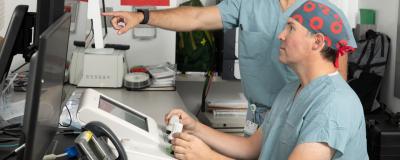A woman in her 50s with no significant medical history experienced a sudden onset of headache, nausea, and vomiting, followed by loss of consciousness on her ride home from work. She was taken to an outside hospital emergency department where, upon arrival, she was awake and confused with no movement on her left side. She became progressively lethargic and was subsequently intubated.
A CT showed diffuse subarachnoid hemorrhage centered on the right sylvian fissure with a component of intracerebral hemorrhage, with no midline shift that was suggestive of a middle cerebral artery aneurysm. CT angiography of her head confirmed a right middle cerebral artery (MCA) bifurcation aneurysm as well as bilateral posterior inferior cerebellar artery (PICA) aneurysms. The patient was then transferred to Rush University Medical Center for further management.
Treatment
Upon arrival to Rush, Dr. Crowley performed a cerebral angiogram to assess the aneurysms and determine whether treatment would be feasible endovascularly, or whether a craniotomy and clipping of the ruptured aneurysm was needed. The MCA aneurysm was noted to be wide-necked and irregularly shaped. The wide neck of the aneurysm made standalone endovascular coil embolization a suboptimal option, as there would be a significant risk of coil herniation into the associated MCA branches. It was felt that coil embolization would require placement of a stent, however this would require dual antiplatelet therapy, which again was determined to be not ideal due to the fact that the aneurysm was ruptured. It was felt that the WEB device was the best endovascular option for this particular aneurysm, and, if it was unsuccessful, the patient would be taken for craniotomy and clipping of the aneurysm.
The procedure was performed through a needle puncture in the femoral artery by placing a catheter in the internal carotid artery which allowed the WEB device to be tracked into the aneurysm. Using continuous fluoroscopy imaging, the WEB device was deployed into the sac of the aneurysm where the flexible mesh conformed to the aneurysm walls and protected the associated blood vessels. Subsequent images showed the aneurysm was immediately shut down with no remaining flow into the aneurysm.
Over the course of her stay the patient’s neurologic exam gradually improved, including return of strength on her left side. After a few weeks she was transferred to Rush Rehab facility, and two weeks later she was able to be discharged home.

Long-term Outcome
At her one year follow-up visit, she was noted to be at her pre-hospitalization neurological baseline, with no negative sequelae from her bleed.
Facts about the Woven EndoBridge (WEB) Aneurysm Embolization System (from the Food and Drug Administration)
What is it? The Woven EndoBridge (WEB) Aneurysm Embolization System is a permanent nitinol (nickel titanium) self-expanding mesh ball implant for the treatment of wide-neck intracranial aneurysms located at or near branching areas of arteries in the brain. The device system consists of the implant, the delivery wire, and the controller that is used to detach the device from the delivery wire.
How does it work? The WEB Aneurysm Embolization System is introduced into the blood vessels either in the groin or the wrist. The WEB implant is then detached from the delivery system and placed into the sac of the intracranial aneurysm. The WEB implant is designed to disrupt blood flow entering the aneurysm and help promote clotting (thrombosis).
When is it used? The WEB Aneurysm Embolization System is indicated for use in the following arteries located in the brain (middle cerebral artery (MCA) bifurcation, internal carotid artery (ICA) terminus, anterior communicating artery (AComm) complex, or basilar artery apex) for the treatment of adult patients with saccular, wide neck, bifurcation intracranial aneurysms with dome diameter from 3 mm to 10 mm and either neck size 4 mm or greater or the dome-to-neck ratio is greater than 1 and less than 2.
Analysis
As a minimally invasive option for treating wide- neck bifurcation aneurysms in certain areas of the brain, the WEB Aneurysm Embolization System is an option for the treatment of cerebral aneurysms that has the potential to substantially impact the delivery of care to patients with these lesions. Due to its ability to be used for wide-necked aneurysms, it may allow some aneurysms that previously
were felt to require craniotomy and clipping to now be treated endovascularly, and avoids the need for long-term anti-platelet therapy that is required with stent placement. This can result in improved safety and shorter recovery times. When used to treat an unruptured aneurysm, patients can typically go home the following day after the device is implanted. By fixing the aneurysm before it ruptures, the threat of an aneurysm bursting and the patient dying from it essentially goes away.
The WEB system has shown to be highly effective and safe. According to the FDA, in a clinical study of 150 subjects in which treatment with the device was attempted, 54.77% of subjects met the primary effectiveness endpoint and achieved a successful treatment (complete occlusion) of their intracranial aneurysm within 1-year post-procedure without re- treatment, recurrent subarachnoid hemorrhage or clinically significant parent artery stenosis.
An estimated 6 million people in the United States have an unruptured brain aneurysm, with 35% of them being wide-necked bifurcation aneurysms. The WEB system may be an option for thousands of these patients, providing a safe, effective alternative to existing treatment options, including potentially avoiding the need for craniotomy and clipping in some patients.

